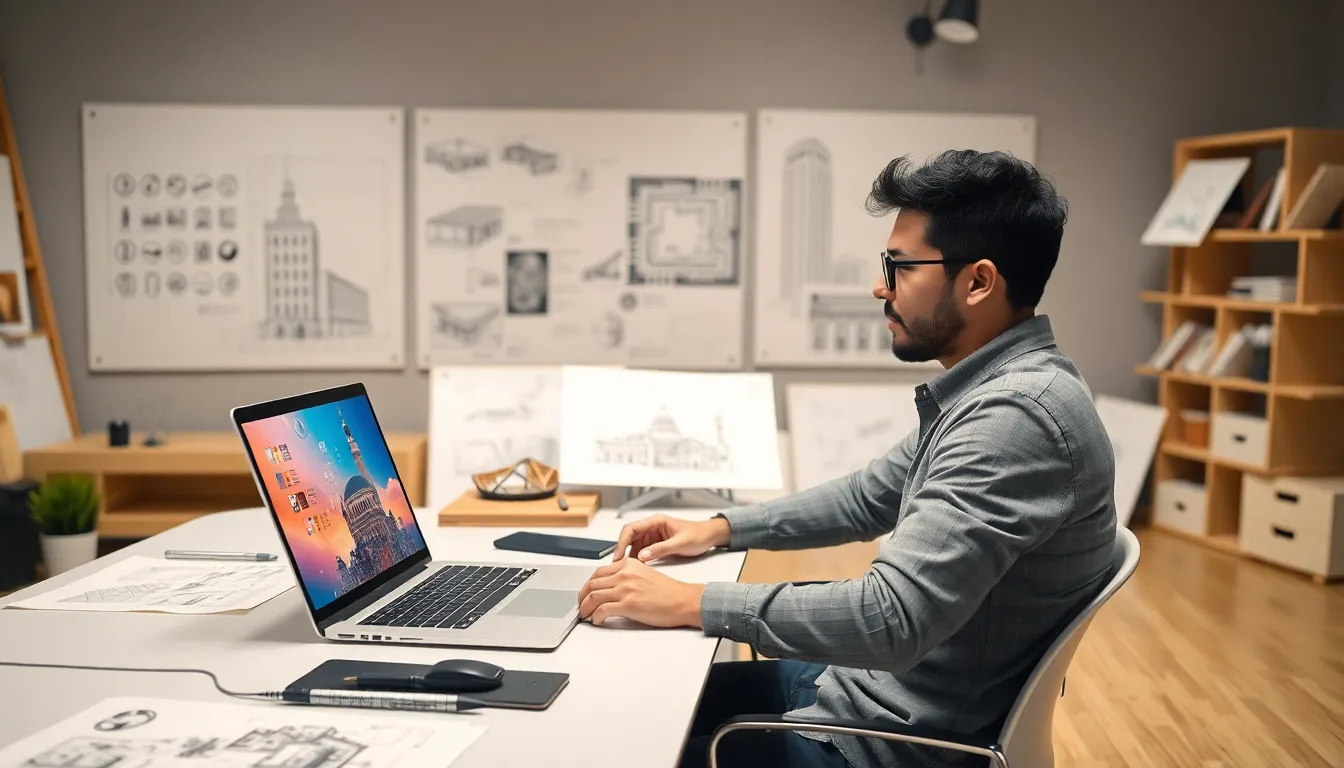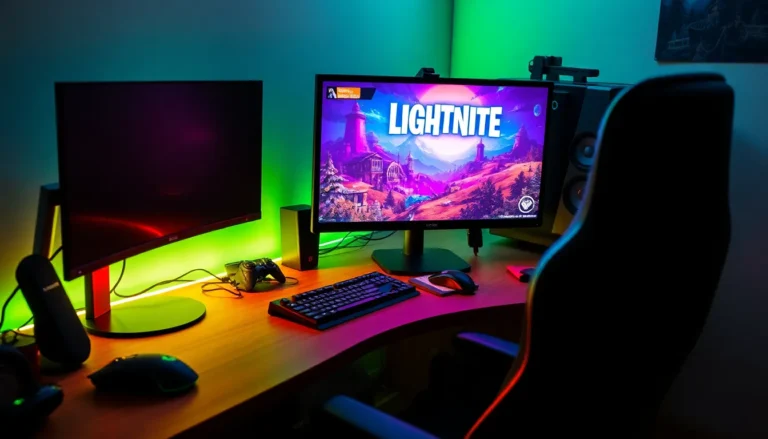Table of Contents
ToggleChoosing the right laptop can feel like picking a favorite child—impossible and fraught with emotional turmoil. For architecture students, this decision becomes even trickier. They need a powerhouse that can handle demanding software while still being light enough to carry around campus. After all, lugging around a brick isn’t exactly conducive to impressing classmates.
Imagine trying to render a 3D model on a laptop that freezes faster than a deer in headlights. It’s not just about aesthetics; it’s about functionality. The right laptop can make the difference between designing a stunning building and watching the spinning wheel of doom. Let’s dive into the essential features that will help architecture students turn their visions into reality, without sacrificing portability or their sanity.
Overview of Laptops for Architecture Students
Selecting a laptop for architecture students poses unique challenges. Performance, portability, and compatibility with architectural software stand out as essential factors. Many students require laptops capable of running resource-intensive applications such as AutoCAD, Revit, and SketchUp. Sufficient RAM, ideally 16GB or more, ensures smooth multitasking and rendering.
Graphics capabilities must meet high standards, making dedicated graphics cards, such as those from NVIDIA or AMD, preferable. Storage solutions also influence performance. Solid-State Drives (SSDs) offer faster load times compared to traditional Hard Disk Drives (HDDs), allowing students to access files quickly.
Battery life holds significant importance. Architecture students often spend long hours on campus or in studios. A laptop with a battery life of at least 8 hours supports uninterrupted work sessions. Portability and weight contribute to overall convenience, especially for those frequently moving between classes and workspaces.
Screen size and resolution also warrant attention. A minimum screen size of 15 inches coupled with a Full HD resolution ensures comfort during long design sessions. High-resolution displays provide clarity for intricate design details and accurate color representation.
In terms of operating systems, students may prefer Windows due to its wide compatibility with industry-standard software. However, MacBooks also serve as a viable option, particularly for students involved in design-focused work where aesthetics and display quality matter.
Ultimately, the right laptop empowers architecture students to contribute their best ideas and designs in a digital environment. Prioritizing functionality over aesthetics stands as a key strategy in this selection process.
Key Features to Consider

Selecting the right laptop involves understanding several key features essential for architecture students. Performance, graphics, and display quality play crucial roles in effective design work.
Performance and Processing Power
Opt for a laptop with at least an Intel i7 or AMD Ryzen 7 processor. These processors handle demanding architectural software smoothly. Prioritize models with 16GB of RAM or more for efficient multitasking and seamless performance during rendering tasks. Many architecture students benefit from laptops that support memory upgrades, ensuring longevity. Make sure to consider storage as well, with Solid-State Drives (SSDs) preferred for faster boot and load times compared to traditional hard drives.
Graphics Capabilities
Dedicated graphics cards significantly enhance design software performance. NVIDIA or AMD graphics cards provide the necessary power for rendering complex 3D models. Look for laptops with at least 4GB of dedicated video RAM for optimal graphics handling. This capability ensures smooth operation of software like AutoCAD and Revit. Prioritize laptops with high-performance GPUs if your work involves extensive graphics rendering.
Display Quality
Display quality affects clarity and comfort during extended design sessions. Choose a laptop with at least a 15-inch screen size and Full HD resolution (1920 x 1080) for crisp visuals. High resolution improves detail visibility, essential for intricate architectural designs. Consider laptops with IPS panels for wider viewing angles and better color accuracy. Brightness levels around 300 nits enhance usability in various lighting conditions, making the device versatile for different working environments.
Top Laptop Recommendations
Selecting the right laptop for architecture students involves considering various options across different price ranges. The following recommendations cater to diverse budgets and preferences, ensuring students find a suitable device for their needs.
Budget-Friendly Options
Several laptops offer great performance without breaking the bank. The Acer Aspire 5 provides a solid balance of specifications with an Intel i5 processor, 8GB of RAM, and a dedicated NVIDIA GeForce MX250 graphics card. This setup allows students to run essential software like AutoCAD effectively. Another viable choice is the Lenovo IdeaPad 3, which features similar specs, including a bright Full HD display. Both options keep costs manageable while delivering the necessary functionality for architectural studies.
Mid-Range Choices
For those willing to invest a bit more, mid-range laptops offer enhanced performance. The Dell XPS 15 combines sleek design with powerful specs, boasting an Intel i7 processor, 16GB of RAM, and an NVIDIA GTX 1650 Ti graphics card. This combination supports smooth multitasking and robust rendering capabilities. Alternatively, the ASUS ROG Zephyrus G14 is an excellent choice, providing outstanding graphics performance with its AMD Ryzen 7 processor and dedicated NVIDIA graphics. Either model ensures students can tackle demanding software without compromise.
High-End Models
High-end laptops stand out for their impressive specifications and performance. The Apple MacBook Pro 16 shines with an M1 Pro or M1 Max chip, offering exceptional power for complex architectural tasks. With 16GB of RAM and high-resolution Retina display, this device excels in graphics accuracy. The Razer Blade 15 also deserves attention, featuring an Intel i7 processor, 32GB of RAM, and NVIDIA RTX 3060 graphics. These high-performance options cater to architecture students seeking top-tier devices capable of running intensive design software seamlessly.
Tips for Maintaining Your Laptop
Keeping a laptop in top shape enhances its longevity and performance. Regularly cleaning the laptop helps avoid dust buildup, especially around the vents and keyboard. Use a microfiber cloth and gentle cleaning solution for the screen.
Updating software consistently ensures the laptop runs efficiently. Install system updates and upgrade architectural software as new versions become available. These updates often include important security patches and performance improvements.
Battery health matters significantly for architecture students needing long workspace hours. Avoid letting the battery drain completely frequently. Charge the laptop when the level drops to 20%.
Using a laptop cooling pad can prevent overheating during demanding tasks. Maintain proper ventilation by not blocking cooling vents. Excessive heat can negatively affect performance and overall durability.
Backing up files regularly is essential for data security. Utilize cloud services or external hard drives to keep important projects safe. This practice minimizes the risk of losing critical design work.
Managing storage space contributes to optimal performance. Regularly delete unnecessary files, and consider using external storage options for large projects. Solid-State Drives (SSDs) offer better speed for accessing files compared to traditional drives.
Protecting the laptop with a sturdy case or sleeve prevents physical damage during transport. Select a well-padded option that absorbs shocks. Prioritizing physical protection maintains the laptop’s condition.
Finally, awareness of hardware usage fosters better maintenance habits. Monitor system performance frequently to identify potential issues. Early detection can prevent more significant problems down the line.
Choosing the right laptop is essential for architecture students striving to excel in their studies. A powerful and portable device can make all the difference in managing demanding software and complex design tasks. With the right specifications including sufficient RAM dedicated graphics and a quality display students can enhance their creative process and productivity.
Investing in a reliable laptop not only supports academic success but also prepares students for the professional world. By prioritizing functionality over aesthetics students ensure they have the tools necessary to bring their innovative ideas to life. With careful consideration and the right choices architecture students can confidently navigate their educational journey and beyond.





